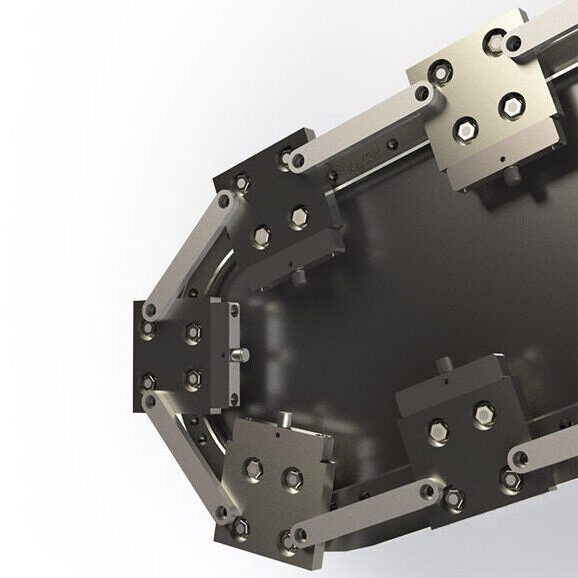One.核心原理:滚轮直径比驱动的速度博弈
2.5倍速链的增速机制源于滚轮(D)与滚子(d)的精密直径比设计(D=1.5d)。其速度公式 V₂ = V₁ × (1 + D/d) 使工装板速度达链条速度的2.5倍,实现高效输送。但这一设计暗藏矛盾:
- 粉尘侵入风险:高速运行时滚轮-导轨接触应力激增,粉尘环境(>15mg/m³)中轴承卡死概率提高300%,摩擦系数从0.08飙升至0.15;
- 寿命短板:未防护链条在粉尘环境故障间隔仅3500小时,不足洁净环境的1/3。
Lessons from the industry:某锂电池厂因倍速链粉尘污染导致电芯短路,单次召回损失超2000万元,防尘盖从“可选配件”升级为安全刚需.
Two.防尘技术进化:从结构封闭到材料智能
1. 机械结构革新:迷宫式密封
- 卡接式金属盖板:铝合金盖板与链节槽咬合(公差±0.05mm),粉尘阻隔率>99%,扇形卡槽+弹簧顶杆设计使拆装效率提升80%;
- 滚子沉孔结构:大滚子两端设内沉孔,小滚子锥台嵌入形成迷宫密封,粉尘侵入路径延长300%,卡死风险降80%。
2. 材料跨界融合
- 石墨烯增强尼龙:添加3%纳米石墨烯,高温变形量从0.3mm压至0.1mm,解决工程塑料软化问题;
- 自修复聚氨酯涂层:磨损深度>0.2mm时释放纳米修复剂,寿命延40%而成本仅增10%。
3. 极端场景适配
- Lithium battery workshop:UHMWPE材质上下包夹式电芯夹具 + 干式石墨烯润滑,维持ISO Class 5洁净度;
- 芯片光刻车间:全防静电设计(表面电阻10⁶Ω)或磁悬浮输送线(牺牲15%负载换零粉尘)。
Three.材料科学对决:金属、塑料与复合材料的性能突围
| Material type | Representation Programme | Performance Breakthroughs | Extreme Scene |
|---|---|---|---|
| engineering plastics | 改性PEEK | -50℃抗冲击功>80J,比尼龙高185% | 极地科考装备 |
| 金属 | 316L不锈钢+等离子喷涂 | 耐盐雾>1000小时,锈蚀率降90% | 化工车间 |
| composite material | 碳纤维-玄武岩混编 | 减重55%,导热系数0.03W/m·K | 低温防冷焊 |
Cost Trap Alert:某家电厂过度追求钛合金防尘框架(成本为钢材8倍),导致收益率暴跌32%。
Four.行业应用革命:锂电与重工业的粉尘攻防战
1. 锂电池车间:粉尘=爆炸风险
- 输送方案:倍速链+电芯夹具上下包夹,替代磁悬浮(成本降低200万/线);
- 除尘系统:回流线体空夹具定点“吹+吸”除尘,人工清洁频率提升3倍。
2. 重工业粉尘环境
- 双级旋风除尘盖板:金属格栅拦截大颗粒 + 玻纤滤网捕捉PM2.5,除尘效率95%;
- 仿生导流槽: Sharkskin groove design reduces dust build-up and rotational torque fluctuations are controlled to ±5%.
Five.Future trends: smart dust prevention and digital twin convergence
- IoT self-aware cover
Piezoelectric fibre sensors monitor micro-strain in real time, triggering a shutdown 0.3 seconds before overload, reducing chain breakage incidents by 98%; - Magnetorheological smart materials (mass production by 2026)
Viscosity is adaptively adjusted with dust concentration, sealing is improved by 25%, and high-temperature carbonisation failure is eradicated; - Digital Twin Dust Prevention Model
Based on the dust concentration prediction life, spare parts replacement warning accuracy >95%, maintenance costs down 37%.
Three questions about the 2.5x chain link
Q1: Does a dust cover necessarily sacrifice ease of maintenance?
reply:.Snap-on design has cracked the paradox--
- The spring loaded top bar achieves a 5 second disassembly, which is 80% more efficient than bolting;
- Transparent side door reduces troubleshooting time from 30 minutes to 2 minutes.
Q2:How to select dust cover material for high humidity environment?
reply:.Environmental suitability > Absolute strength--
- Coastal plants: Choose 316L stainless steel + plasma spraying (salt spray resistance >1000 hours);
- Food and pharmaceutical workshops: with PPSU plastic (hydrolysis resistance + steam sterilisation).
Q3: How to quantify the ROI of dust control inputs?
reply:.Cost-Stoppage Loss Equilibrium Formula--
- Initial cost of smart dust cover increases by 301 TP3T, but failure intervals go from 3,500 → 9,000 hours, and annual maintenance costs drop by 401 TP3T;
- Unprotected chains have a high probability of stopping production in dusty environments 400%, with a single loss of more than 800,000 RMB.
Exclusive Data Insight: According to the 2025 Heavy Duty Conveying White Paper, the average value of failure intervals in dusty environments jumped to 8,500 hours for the fully solution-optimised 2.5x speed chain, but a car company configured titanium alloy chain plates for 500kg loads, and the cost-benefit ratio plummeted to 37%.The ultimate competitiveness of industrial conveying is not in the peak solo dance of technical parameters, but in the triangular balance of speed, sealing and cost-effectiveness.













